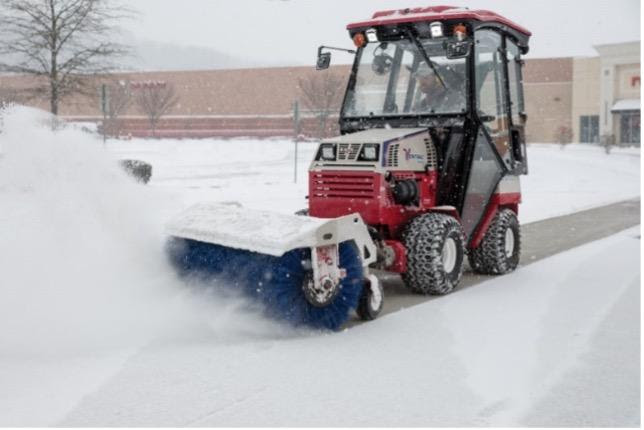While snow and ice events during the winter months create challenging conditions everywhere, our more urban environments present specific concerns that are not as prevalent in suburban or rural locations. In these more densely populated areas, snow clearing and related de-icing activities are critical in keeping life moving and ensuring passages are safely cleared for drivers and pedestrians. As we head into the snowiest months of the year, cities throughout the country are well underway arranging their winter weather preparedness and response. Below, we share several challenges that snow removal companies face in urban sites and best practices to overcome these difficulties.

Smaller Roads
In an urban environment, roadways are often smaller and more congested, making them more difficult to navigate with snow plow trucks. Other factors such as street side parking, pedestrian crosswalks, and most recently curbside eateries limit the areas to potentially pile and store snow. Often times the aftermath of clearing city streets becomes the issue of property owners as the accumulated snow ends up on their sidewalks or blocking access to their parking lots. To combat this problem especially during the largest storms, it’s important to have a plan in place to remove excessive snow and relocate it to off-site locations. This work is often completed during the overnight hours and requires the use of heavy equipment, dump trucks, labor... and perhaps most importantly a location to store the snow.
Larger Sidewalks
As a general observation, sidewalks in the city are much larger and far more heavily travelled than sidewalks in less populated areas. Greater volumes of pedestrians traversing across newly fallen snow can lead to compacted snow and ice in these most travelled areas, making it critical to clear snow quickly. While the traditional snow shovel will always have a role in clearing walkways, the use of specialized equipment makes for a more advanced solution to clear these areas effectively and efficiently. Leading snow removal companies are utilizing mechanized tools such as compact stand on plows like the SnoRator or Ventrac, power brooms, and enclosed cab utility vehicles (UTV) to deliver a better end result in less time.

Specialty Areas
When severe weather hits, you often think of roadways and sidewalks to be the most crucial areas to clear of snow. But what about parking garages, loading docks, and high-rise buildings with decks and terraces? These areas all require specialized de-icing materials and have weight restrictions. Understanding the different materials and equipment needed for each surface application is critical to success and to help reduce long term wear and tear.
require smaller equipment that meets height and weight restrictions. Rubber or polyurethane
Parking decks
blades are used to reduce potential damage to the specialized surfaces, and a non-corrosive
de-icing material is needed to prevent spalling of concrete. In the most extreme of situations,
helipads, sometimes on hospital roofs, require the use of highly specialized de-icers approved
for the aviation industry.

Nowhere to Place Snow
After roadways and sidewalks are cleared by snow plow trucks, do you ever wonder where all the snow ends up? In a major city, there is very limited snow storage, and because of the high foot traffic, snow cannot just be piled up on sidewalks or the side of the road. Property Owners and Managers need to prepare for this by choosing a snow removal company near me
that recognizes where to best locate cleared snow, avoiding critical areas like crosswalks, valet drops, parking garage entries, fire stands, and loading dock access points. Ensuring that your selected snow contractor has the know how and ability to haul snow away in larger events should be a critical consideration.

Shade and Refreeze
Typically, downtown areas are concentrated with high rise structures that are very close together. This condition often creates a very shaded environment at the ground level, which in turn can lead to ice and snow which is not directly exposed to the sun and therefore difficult to melt. At the same time, it is common for daytime temperatures to rise above the freezing mark, while plummeting after the sun sets, leading to continual cycles of thaw and refreeze. To effectively combat both of these scenarios, it is important to continue to monitor site conditions for several days after actual snow events and to be prepared to spot treat areas impacted on a routine basis.
Want to Learn More?
To learn more about snow removal in urban areas, as well as all facets of commercial snow removal, ice management, and landscaping services, reach out to the experts at Cenova at 877-334-2348 or by emailing cenova@cenovainc.com.





